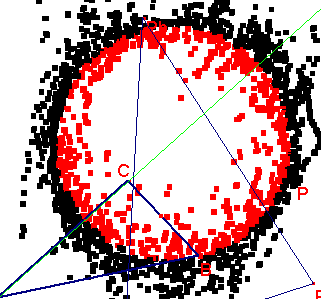
You define a "symmetric-lateral Triangle" of point P about triangle ABC as the triangle with vertices P_a, P_b, P_c, where these are the reflections of point P over BC, AC, and AB. One of the questions asked was "What is the locus of points P that have an isosceles symmetric-lateral triangle?" (See www.cabri.net/problemes for a diagram.)
I worked a bit on this with "Geometer's Sketchpad." The first thing that I did was to draw the dynamic shapes. I asked for measurements from P_a to P_b and from P_b to P_c. I moved point P around and looked at how the measurements compared. I want them to be equal to form an isosceles triangle. I found that there was a strip of places that seemed close. I subtracted the two distance measures to find how far off I was from zero. Then I chose to trace the point P with the color changing parametrically with the difference of the two sides of the triangle. I had it set that differences greater than 1 would be red, differences less than -1 would be violet with those in between producing a spectrum of colors, with the desired distance of zero a green. When I moved point P around, I could see a circular shape of green.

(Note: this image is from a CabriII+ file reconstructed after the description)
This circle seems to be the locus desired. I noticed that it passes through point B of the triangle - which made sense when I thought about it. At first I thought that the circle might go through the midpoint of AC. This didn't make sense when I thought about it. Moving some of the original triangle vertices around and repeating made me notice that the point, D, on AC seems to be where the bisector of angle ABC meets AC. This gives me two points on the circle: B and D. Thus the center of the circle must be on the perpendicular bisector of BD. The center of the circle also will be on line AC. This defines the circle. I tested this guess by trying several examples. It seems to work. I haven't yet proved it...
John Berglund